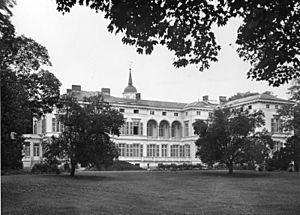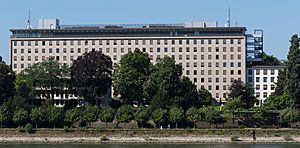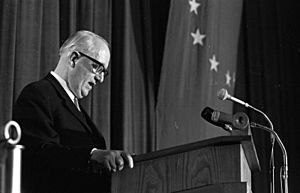Walter Hallstein facts for kids
Quick facts for kids
Walter Hallstein
|
|
|---|---|
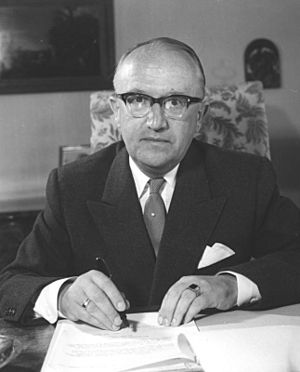
Hallstein in 1957
|
|
| President of the European Commission | |
| In office 7 January 1958 – 30 June 1967 |
|
| First Vice-President | Sicco Mansholt |
| Preceded by | Position established |
| Succeeded by | Jean Rey |
| State Secretary at the Federal Foreign Office | |
| In office 2 April 1951 – 7 January 1958 |
|
| Preceded by | Position established |
| Succeeded by | Hilger van Scherpenberg |
| Member of the Bundestag | |
| In office 28 September 1969 – 19 November 1972 |
|
| Constituency | Neuwied |
| Personal details | |
| Born |
Walther [sic] Peter Hallstein
17 November 1901 Mainz, German Empire |
| Died | 29 March 1982 (aged 80) Stuttgart, West Germany |
| Resting place | Waldfriedhof Cemetery, Stuttgart, Germany |
| Political party | Christian Democratic Union |
| Alma mater | Friedrich Wilhelm University |
| Military service | |
| Allegiance | |
| Branch/service | |
| Years of service | 1942–1945 |
| Rank | Oberleutnant |
| Battles/wars | World War II
|
Walter Hallstein (born 17 November 1901 – died 29 March 1982) was a German expert in law, a diplomat, and a statesman. He became the first President of the European Economic Community (EEC) Commission. He is also known as one of the founding fathers of the European Union.
Hallstein started his career as a law professor in the 1920s. By 1930, at age 29, he was Germany's youngest law professor. During World War II, he served as a First Lieutenant in the German Army in France. American troops captured him in 1944. He spent the rest of the war in a prisoner-of-war camp in the United States. There, he even set up a "camp university" to teach his fellow soldiers.
After the war, he returned to Germany and continued his academic work. He became the head (rector) of the University of Frankfurt in 1946. In 1948, he was a visiting professor at Georgetown University in the US. In 1950, he began a career in diplomacy. He became a top civil servant at the German Foreign Office. His name is linked to the Hallstein Doctrine, which was West Germany's policy to isolate East Germany diplomatically.
Hallstein strongly believed in a united Europe. He played a key role in West German foreign policy and in bringing European countries closer together. He helped create the European Coal and Steel Community. He was also the first President of the Commission of the European Economic Community (EEC). The EEC later became the European Union. He held this position from 1958 to 1967. Hallstein famously said his job was "a kind of European prime minister." He thought that national borders were an old idea.
Hallstein left his position after a disagreement with the French President, Charles de Gaulle. He then entered German politics as a member of the Bundestag (German parliament). He also led the European Movement from 1968 to 1974. He wrote many books and articles about European integration.
Contents
Early Life and Education
Walter Hallstein was born on 17 November 1901 in Mainz, Germany. He was the second of two sons. His father, Jakob Hallstein, was a senior railway official.
From 1913, he attended a classical school in Mainz. He finished school in 1920.
From 1920, Hallstein studied law in Bonn, then Munich, and finally Berlin. He focused on international private law. In 1925, at age 23, he earned his doctorate from the Friedrich Wilhelm University in Berlin. His paper was about insurance contracts in the 1919 Treaty of Versailles.
After working as a legal clerk and a judge, he became an academic at the Kaiser Wilhelm Institute for Foreign Private and International Private Law in Berlin. He specialized in business and company law. In 1929, he completed his Habilitation (a higher academic degree) on company law.
In 1930, at age 29, he became a professor of private law and company law at the University of Rostock. This made him Germany's youngest law professor. He became Deputy Dean of the Law Faculty in 1935 and Dean in 1936. He stayed in Rostock until 1941. From 1941 to 1944, Hallstein taught at Frankfurt University.
Hallstein was a member of some professional groups that were linked to the Nazi party. However, he was not a member of the Nazi Party itself. He was known for not supporting Nazi ideas. In 1941, some Nazi officials tried to stop him from becoming a professor at the University of Frankfurt. But other academics supported him, and he became Dean of the faculty.
Soldier and Prisoner of War (1942–1945)
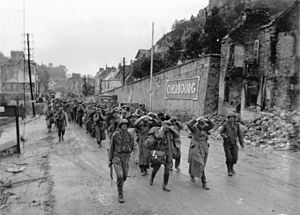
In 1942, Hallstein was called to serve in the German army (Wehrmacht). He was a first lieutenant in an artillery unit in Northern France.
On 26 June 1944, during the Battle of Cherbourg, American soldiers captured him. He was sent to Camp Como, a prisoner-of-war camp in Mississippi, USA.
As a German prisoner of war, Hallstein started a "camp university." He taught law courses to other prisoners. He also attended a special school at Fort Getty to learn about the principles of the Constitution of the United States. Hallstein remained a prisoner from June 1944 to mid-1945.
Post-War Academic Career (1945–1950)
In November 1945, Hallstein returned to Germany. He worked to reopen Frankfurt University. He became a professor there on 1 February 1946. In April, he was elected its head (rector), a role he held until 1948. He also led the South German Rectors' Conference, which he helped create. From 1948 to 1949, he was a visiting professor at Georgetown University in Washington D.C.
Hallstein also helped create the German national UNESCO committee. He was its president from 1949 to 1950.
Diplomatic Career (1950–1957)
Starting Foreign Affairs Work (1950–1951)
After World War II, Europe was badly damaged and divided by the Iron Curtain. Many people wanted European countries to work together more closely. The French foreign minister, Robert Schuman, proposed a plan to unite German and French coal and steel production. This plan came from Jean Monnet.
Germany had not yet fully regained its independence after the war. The Allied High Commission represented Germany internationally. There was no German foreign office at first. So, the German Chancellor's office handled foreign affairs.
Konrad Adenauer, the German Chancellor, invited Hallstein to Bonn. In June 1950, Adenauer appointed him to lead the German team at the Schuman Plan talks in Paris. These talks aimed to create the European Coal and Steel Community.
Jean Monnet and Hallstein worked together on the Schuman Plan. This plan became the basis for the European Coal and Steel Community (ECSC), which started in 1951. The ECSC later grew into the European Economic Community and then the European Union.
In August 1950, Hallstein was made head of the Office of Foreign Affairs at the Chancellor's office. At that time, not much was known about Hallstein, except that he had not been a Nazi Party member and had good relations with US officials.
State Secretary at the Foreign Office (1951–1958)
In March 1951, the German Foreign Office was re-established. Chancellor Adenauer himself became the Foreign Minister. On 2 April 1951, Hallstein became the top civil servant at this new Foreign Office.
Adenauer, with a small group including Hallstein, continued to manage foreign policy. Hallstein was almost like the Foreign Minister, even though he didn't hold the title.
Hallstein also played a key role in helping West Germany regain its sovereignty (independence) and create a European Defence Community. This community would include West Germany.
Negotiations led to two agreements in 1952:
- The Treaty of Bonn (May 1952) would give West Germany more independence.
- The Treaty of Paris (May 1952) would have created the European Defence Community.
However, the French Parliament did not approve the Treaty of Paris. Instead, a new solution was found involving the Western European Union (WEU). West Germany then joined NATO.
These efforts led to conferences in London and Paris in 1954. Adenauer, Hallstein, and other top officials represented Germany. Hallstein helped negotiate several treaties at these conferences. The Paris Accords were ratified on 5 May 1955. This restored West German sovereignty, and Germany became a member of NATO.
After these major foreign policy goals were achieved, Hallstein worked on rebuilding Germany's diplomatic service and reorganizing the Foreign Office.
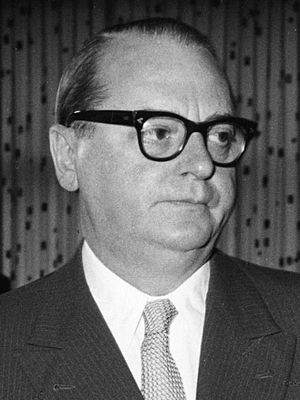
On 6 June 1955, Adenauer appointed Heinrich von Brentano as Foreign Minister. Hallstein kept Adenauer's trust and continued to attend cabinet meetings.
Hallstein was also involved in talks with France about the Saar region. In October 1955, a vote was held in the Saar. It was decided that the Saar would rejoin Germany. The Saar Treaty was signed on 27 October 1956.
The Hallstein Doctrine
By 1955, Germany had largely regained its independence and joined Western defense groups. European integration had also progressed. Now, German reunification and relations with East Germany were important issues. Hallstein focused more on Western European integration. His deputy, Wilhelm Grewe, handled much of the work on East Germany.
In 1955, Hallstein and Grewe went with Adenauer to Moscow. There, West Germany and the Soviet Union agreed to establish diplomatic relations. On the flight back, they developed the policy that became known as the Hallstein Doctrine. The main idea came from Grewe.
This doctrine was a key part of West German foreign policy from 1955 until 1969. It meant that West Germany claimed to represent all of Germany, including Communist East Germany. West Germany wanted to isolate East Germany diplomatically.
The doctrine stated that West Germany would see it as an "unfriendly act" if other countries recognized East Germany or had diplomatic relations with it. The only exception was the Soviet Union, because it was one of the four powers responsible for Germany. An "unfriendly act" could lead to West Germany breaking off diplomatic relations.
European Integration and the Rome Treaties
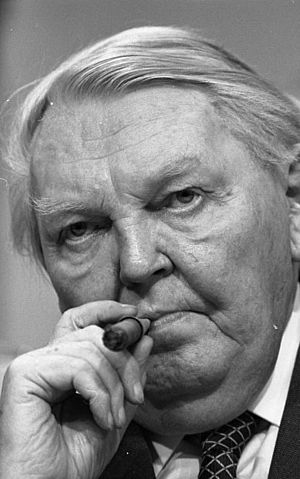
Members of the German government had different ideas about European integration. Hallstein and his team wanted a federal Europe. This meant countries would give up some power to a central European body. They wanted to start with the European Coal and Steel Community and gradually add more areas.
Hallstein believed that this kind of integration would help Germany's export industry. However, Ludwig Erhard, the Economics Minister, wanted looser cooperation between governments. He was against powerful central European bodies. Adenauer supported Hallstein in this disagreement.
In 1955, foreign ministers of the European Coal and Steel Community met at the Messina Conference. This meeting led to the signing of the Treaty of Rome in 1957. Hallstein led the German delegation at this conference.
The conference aimed to restart European integration after plans for a European Political Community failed in 1954. In 1956, the Spaak Report suggested a customs union. This meant countries would remove tariffs (taxes) on goods traded between them. Hallstein supported this idea.
Other ministers, especially from the Economics and Agriculture ministries, opposed the plans for a common market. They feared it would lead to protectionism or harm German farmers. But Chancellor Adenauer again supported Hallstein.
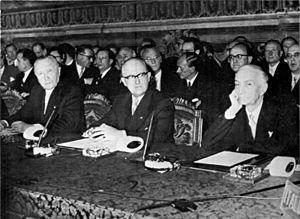
Another issue was including French overseas territories in the common market. Erhard strongly opposed this. Hallstein, however, was willing to accept it to gain French support. He helped make a deal that opened these territories to German exports.
On 25 March 1957, six countries (Belgium, France, Germany, Italy, Luxemburg, and Netherlands) signed the Treaties of Rome. Adenauer and Hallstein signed for Germany. Hallstein had largely led the negotiations, so this was a big success for him. He also explained the treaties to the German parliament (Bundestag) before they were signed.
Choosing the Commission President
Hallstein was suggested as the German candidate for the president of the new European Commission. Other strong candidates were Rey from Belgium and Mansholt from the Netherlands. The foreign ministers could not decide in December 1957.
However, at a meeting on 6 and 7 January 1958, Hallstein was finally chosen. He became the first president of the EEC Commission. His selection for this important European role, just a decade after World War II, was a major achievement for Germany.
President of the European Economic Community Commission (1958–1967)
Building the EEC
Walter Hallstein was unanimously elected the first president of the Commission of the European Economic Community (EEC) in Brussels. This happened on 7 January 1958, less than ten years after World War II ended. He stayed in this job until 1967.
Hallstein's commission had nine members. Their tasks included creating a customs union and ensuring the Four Freedoms (free movement of goods, services, people, and capital). They also worked on common policies for trade, transport, and agriculture.
Hallstein famously called his role "a kind of European prime minister." He believed that national borders were an old idea. While Hallstein wanted a federal Europe, the EEC treaty left many questions open. There were different opinions on whether a common market needed a common economic policy. People also disagreed on whether Britain should join and if the final goal was a "United States of Europe."
Different countries had different interests and traditions. This made it hard to reach agreements. For example, the Common Agricultural Policy (CAP), which protected farmers, clashed with the liberal trade policy.
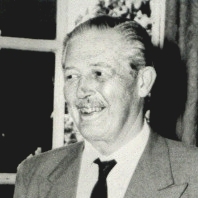
Britain initially opposed the EEC. It preferred a looser free trade area. Later, Britain suggested a larger free trade area that included the EEC. The German government and industry, especially Economics Minister Ludwig Erhard, wanted Britain to be part of a united Europe.
Hallstein, however, thought it was better to first achieve more integration among a smaller number of countries. Discussions about a wider trade area continued. But in November 1958, France, following de Gaulle's orders, suddenly pulled out of the talks. This upset other EEC members and ended the negotiations. Some German politicians felt Hallstein had not done enough to promote the wider free trade area.
The six EEC countries decided on a customs union. They agreed to remove tariffs between themselves within twelve years. They also agreed to have a common tariff barrier for goods from other countries.
Seven other European countries (including the UK) formed the EFTA. EFTA also removed tariffs between its members but did not have a common tariff for other countries.
On 3 March 1960, Hallstein announced a plan to speed up the common market. Some people saw this as undermining hopes for a joint free trade area with EFTA. This displeased EFTA countries and the German Economics Ministry.
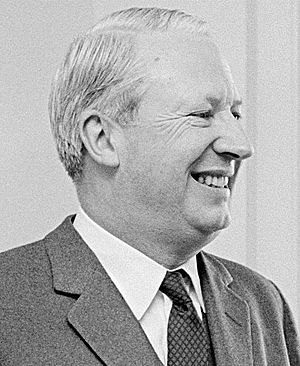
In 1961, Harold Macmillan, the British Prime Minister, decided to apply for the UK to join the EEC. Edward Heath led Britain's negotiations. Hallstein was cautious about Britain joining. He was seen as less enthusiastic than others. Some British newspapers criticized Hallstein.
In 1961, de Gaulle proposed the Fouchet Plan. This was a plan for a "union of states" that would be separate from the European Communities. Other European countries did not support it, and the talks ended in 1962.
Hallstein wanted a federal Europe, where the Commission acted like a central government. De Gaulle, however, wanted a confederation of independent states. Hallstein believed de Gaulle's approach would not create a strong Europe.
De Gaulle wanted Europe to be independent of the United States. He was against closer European integration under American influence.
The Hallstein Commission created plans for an economic and currency union. Hallstein presented these plans in October 1962.
De Gaulle made another attempt to create a closer political union in Europe. This was the Franco-German bilateral treaty in 1963. Other countries and Hallstein criticized this treaty. They felt it was not compatible with the EEC and NATO treaties. When Germany approved the treaty, it added a statement. This statement confirmed Germany's commitment to close ties with the US and to expanding the European Communities. De Gaulle saw this as a failure.
De Gaulle also vetoed Britain's application to join the EEC in 1963. This further angered the other member states.
Disagreement with de Gaulle
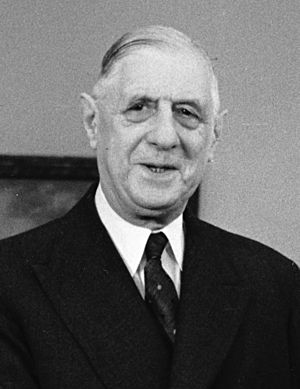
De Gaulle took a strong stance on the Common Agricultural Policy (CAP). In October 1964, France threatened to leave the EEC if the European Agricultural market was not set up as agreed. On 1 December 1964, Germany agreed to France's demands for a common wheat price.
Differences between France and the Commission, especially between de Gaulle and Hallstein, grew. This was worse when France held the rotating presidency of the Council from January to June 1965.
The Council of Ministers asked the Commission to propose how to finance the CAP from July 1965. This included using direct taxes instead of national contributions. This would mean money would go directly to the Community. Other countries, like the Netherlands, said their parliaments would only approve this if the European Parliament gained more power.
On 20 January 1965, the European Parliament asked governments to strengthen a democratic and federal Europe. Hallstein supported this. He believed other countries agreed with him. He decided to risk a confrontation with de Gaulle.
On 24 March 1965, Hallstein presented the Commission's proposals for financing the CAP to the European Parliament. He suggested that customs duties collected at EEC borders should go to the community budget. He also proposed that the customs union for industrial products be implemented two and a half years earlier than planned.
These proposals would give the Community its own money and more power to the European Parliament. They also suggested that from 1 January 1966, voting in the Council would be by simple majority. This would remove the power of individual countries to block decisions. The French government said it could not agree to this.
Hallstein had the support of the Parliament. The proposals became public before they were presented to the Council. France rejected the idea of more power for the European Parliament and the Community having its own money. De Gaulle accused Hallstein of acting like a head of state. France was worried that its CAP could be challenged by other members under a majority system.
A compromise was initially reached to delay agricultural taxes until 1970. But at a Council meeting on 28 June, the Netherlands and Italy insisted that all the Commission's proposals be discussed together. Germany supported this.
Hallstein refused to make a deal that would weaken the proposals. On 30 June 1965, after talking with de Gaulle, the French minister announced that no agreement had been reached. France's presidency of the Council ended that day.
The Empty Chair Crisis
A few days later, de Gaulle ordered France to stop attending all meetings of the Council of Ministers and other groups that dealt with new decisions. The French representative was recalled.
Hallstein and the French Vice-President of the Commission, Marjolin, created a new plan. This plan continued the temporary arrangement for agricultural finances until 1970.
However, de Gaulle remained against Hallstein and the "technocrats" in Brussels. In September 1965, he publicly opposed majority voting and the Commission's political role. Since treaty changes needed everyone's agreement, there was a deadlock. Hallstein saw this as a breach of treaty obligations.
On 20 October 1965, the French minister pushed for changes to the treaties. The other five member states opposed this. They said a solution "must be found within the provisions of the existing treaties." As a compromise, they offered an special meeting of the Council to discuss the "general situation of the Community," without the Commission.
De Gaulle accepted this offer. In January 1966, the six foreign ministers agreed to suggest that the Commission consult with national representatives before making major proposals. They also agreed not to publish proposals before the Council had dealt with them. The French delegation's opinion was noted: for very important national interests, discussions should continue until everyone agreed.
This became known as the Luxembourg Compromise. It meant that majority decisions were avoided. It became a de facto veto, requiring everyone to agree for Council decisions. Some concessions were also made to France. For example, diplomats no longer presented their papers to Hallstein alone.
The "Empty Chair Crisis" lasted from 30 June 1965 to 29 January 1966.
When the crisis ended, France insisted that Hallstein leave his position. They wanted someone else to lead the new commission, which would combine the EEC, ECSC, and Euratom.
Hallstein's term ended on 8 January 1966, but no replacement was agreed upon. He stayed in office temporarily. The planned merger of the three communities was also delayed.
Given the conflict with de Gaulle, there was a proposal for Hallstein to serve another six months. The German Chancellor, Georg Kiesinger, agreed. But Hallstein felt this broke the Treaty. On 5 May 1967, he asked not to be nominated again.
This showed that national governments did not want the Commission to become a powerful European executive. This blocked Hallstein's dream of a United States of Europe.
Reasons for the Confrontation
De Gaulle respected Hallstein's work for European integration. But he thought Hallstein was serving German interests. De Gaulle disliked the high status given to Hallstein, whom he saw as just a technical expert. Hallstein, on the other hand, made sure he was treated like a head of state.
De Gaulle complained that the Commission was taking on a political role meant for governments. He attacked Hallstein personally, saying he was trying to turn the EEC into a superstate with Brussels as its capital. He spoke of defending French democracy against "a technocratic group, stateless and unaccountable."
According to Der Spiegel, de Gaulle's complaints included:
- Hallstein meeting frequently with US presidents, even though the Commission had no foreign relations role.
- Hallstein claiming to be a "European prime minister."
- Ambassadors from 65 countries being accredited to the European Commission.
- Foreign ambassadors presenting their papers to Hallstein.
- Commission staff taking part in international trade talks.
Hallstein explained his view in an interview: "In principle, we have no political powers... because the Rome Treaty does not mention them. But we have political responsibility because we are a political—not an economic—project. The Common Market aims to unite Europe politically."
The main issue that started the Empty Chair Crisis was the financing of the common agricultural policy. This was very important to France. From 1962 to 1964, France received 85% of all money from the agricultural fund.
The clash between Hallstein and de Gaulle showed two different ideas for Europe. The disagreements included:
- Whether the United Kingdom should join.
- How to pay for the Common Agricultural Policy.
- The rights of the European Parliament, especially over the budget.
- Majority voting in the Council of Ministers.
On most of these points, de Gaulle saw Hallstein as an opponent. Hallstein even compared de Gaulle's actions to those of Hitler.
Later Life (1967–1982)
Hallstein left the Commission at the end of 1967, at age 68.
On 20 January 1968, Hallstein was elected president of the European Movement. This was a private group that supported European integration. He continued to promote his idea of a "United States of Europe." He held this position until 1974. Jean Rey, who also followed him as Commission President, took over.
In 1969, Helmut Kohl offered Hallstein a chance to run for parliament. Hallstein was seen as a possible future foreign minister. He wanted to challenge de Gaulle's attempts to weaken the European Community. However, his party lost the election. Hallstein became a member of the Bundestag (German parliament) but had no government job.
From 1969 to 1972, he was a member of the German Federal Parliament for the Christian Democratic Union. He was on the Foreign Affairs Committee and spoke for his party on European issues. He supported the party's youth organization. He was not nominated for re-election in 1972.
In his speeches in the Bundestag, he continued to share his vision of European unity. He also supported direct elections for the European Parliament. At that time, members of the European Parliament were chosen by national parliaments. Direct elections were introduced in 1979.
After leaving the Bundestag in 1972 and the European Movement in 1974, Hallstein retired from active politics. He moved to Stuttgart and continued to write and give talks.
Hallstein became ill in early 1980. He died in Stuttgart on 29 March 1982, at age 80. He was buried after a state funeral on 2 April 1982 at the Waldfriedhof Cemetery in Stuttgart.
Hallstein never married.
Hallstein's Vision for Europe
Hallstein's main idea for Europe was a federal system. He called European integration a "revolutionary effort" that would take a long time. He believed that the threat from the Soviet bloc and the risk of conflict within Europe made integration necessary.
Hallstein and his team wanted a strong legal framework for Europe. They supported a "supranational" idea. This meant countries would give up some of their power to a European body. This was different from Ludwig Erhard's view, who wanted looser economic cooperation based on free trade.
Hallstein supported the idea of a European Defence Community, which never happened. He also believed that West Germany's integration with Western countries was important for solving other problems, like German reunification.
In a 1953 speech, Hallstein spoke of three "dimensions" of European integration:
- Intensity: How much power member states give up to a central European community.
- Extensity: The number of member states in the community.
- Time: The order and speed of steps towards full integration.
He believed there was a trade-off. For example, more members might mean less integration in a certain time. His model allowed for different European organizations with different sizes and levels of integration. This was important for the United Kingdom, which preferred looser intergovernmental groups.
Hallstein first aimed for economic integration. But he saw this as a way to achieve political unity. He believed the Schuman Plan would help Europe become an equal partner to the United States. It would also help Germany "rejoin the organized community of free peoples."
He imagined a gradual process with many projects coming together. He called this "material logic." This meant setting things up so that people would naturally choose the desired path in the future. For example, common tariffs would lead to a need for a common trade policy. Free movement of people and money would lead to common taxes and a common currency.
The Schuman Plan was the first step in economics. The next step was defense. These steps would then lead to integration in related areas like social policy, energy, and foreign policy.
Hallstein wanted a Europe based on the rule of law. He saw Europe as a "community" based on democracy and law. It was not a federation (because it wasn't a single state yet) but also not a confederation (because it had power over citizens in member states).
As a lawyer, Hallstein believed a strong legal foundation was essential. His idea of a federal Europe was inspired by the federal systems of Germany, the United States, and Switzerland.
Hallstein later wrote that his experience with Nazi Germany made him distrust the idea of absolute national power. He also disliked the British idea of a European balance of power. He became interested in the US Constitution and American history. He saw that the early United States, as a confederation, faced problems because states defended their power. He believed Europe should follow the American path towards a federal solution. However, he wanted Europe to keep its diversity and not become a "melting pot."
Works
Hallstein wrote many publications, more than 365 in total.
His most famous book for the general public was Der unvollendete Bundesstaat (The Unfinished Federation), published in 1969. This book shared his political ideas. A later English version was called Europe in the Making.
He also wrote many academic books and articles. He gave countless speeches, some of which were published in a book called Europäische Reden (European Speeches).
Images for kids
See also
 In Spanish: Walter Hallstein para niños
In Spanish: Walter Hallstein para niños


